流體力學概念
在水中有效率的使用單蹼以達到良好成績表現,需要對單蹼游泳技術有所了解,而在了解單蹼技術之前,需要先了解流體力學的
規則。這些規則讓我們了解在水這個環境中該如何運動,並建立一些技術上的原則讓我們遵守,這些原則我會在下一篇討論。
在水中移動時,我們會遭遇且同時創造阻力,這些阻力傾向讓妳/妳變慢。先談談游泳的阻路
一些从英文翻译过来的技术术语可能与中文术语不完全一致。
我希望在各位讀者之中能幫助我找到我更精確的翻譯。歡迎來信於以下電子郵件更正:theo@ylon.com
游泳阻力
在了解不同的形式的阻力前,要先明確辨別兩種概念,「迎風面積」與「體形系數」
-「迎風面積」指的是在移動過程中,身體前方直接與水接觸的範圍
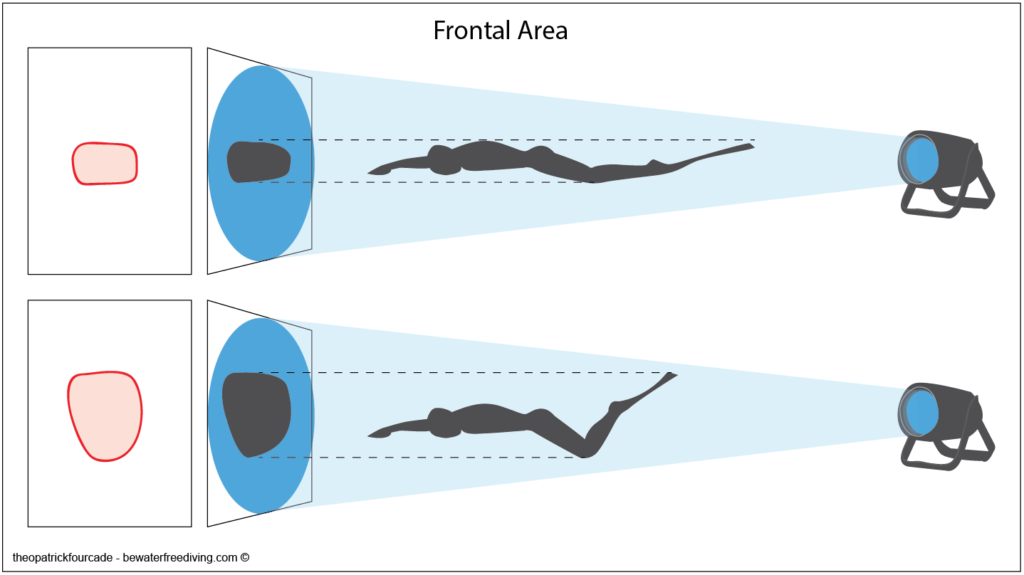
-「體型係數」是指整個身體的形狀,同樣的迎風面積可以代表不同的身體形狀。
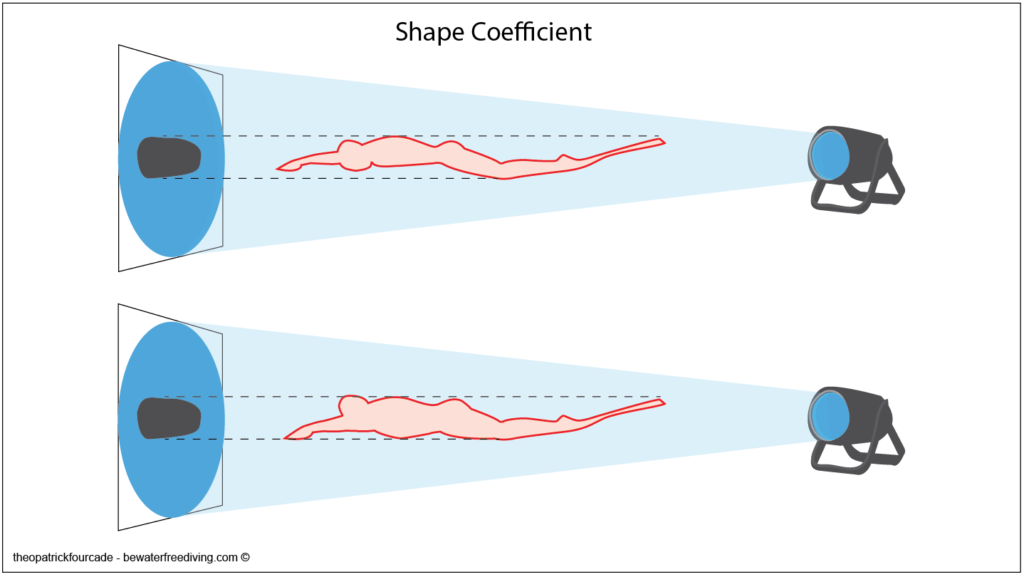
在水中移動時會產生阻力,所有的阻力統稱為 “Shape resistance” ,其中包含三種(由 Counsilman,1986 定義):
– 前端阻力 (Frontal resistance)
– 摩擦阻力 (Friction resistance)
– 流體阻力 (Drag resistance)
這些阻力稱為被動阻力,是水在流經過身體時被動生成的結果。
前端阻力
此阻力是由身體在水中移動方向的截面積造成,此截面積稱為迎風面積,在穿過水的時候會產生阻力。

摩擦阻力
在水中游泳時,最靠近身體(或防寒衣)表面的水分子會附著在身體上,因此這些分子的速度幾乎是零。
這些分子離開表面時開始加速,直到速度和 outside flow. Because two infinitely adjacent layers of water have different speeds, this results in high viscosity forces. We are talking about Friction resistance (Jacques Lachnitt 1978).

流體阻力 (Drag resistance)
是由漩渦造成的阻力,又稱為末端吸力,對於往前移動來說,這個阻力是極其不利的,會在身體的後方產生一股吸力。

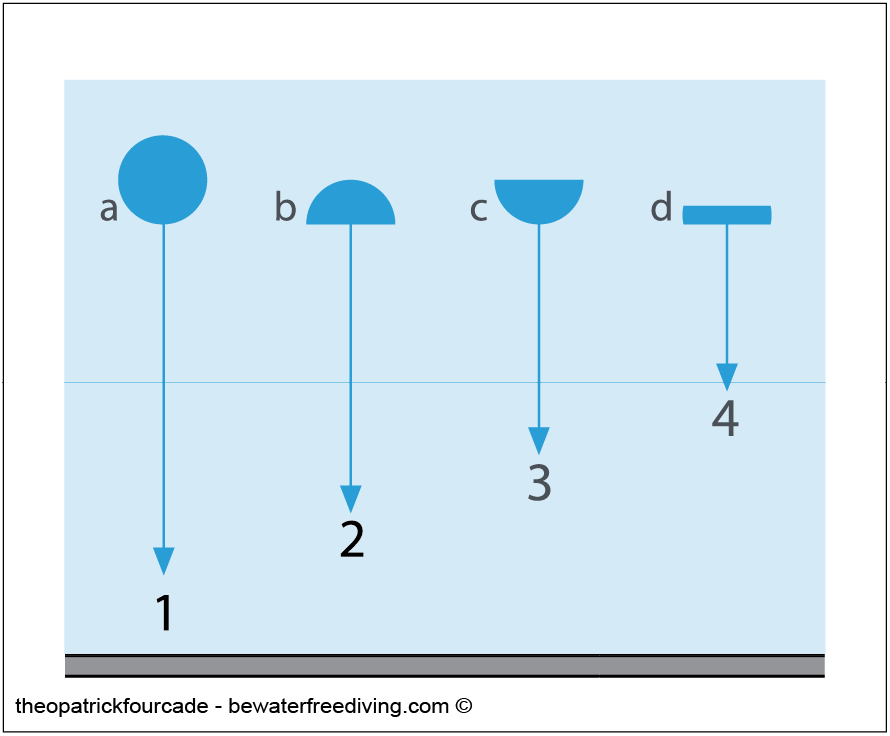
NB : 前端阻力和流體阻力,誰對速度的負面影響比較大呢?根據以下實驗的結果可以看到有趣的答案,分別有四個質量和迎風面積相同
,但形狀不同的物體 A,B,C,D 。再從同樣高度落下,且假設下墜過程都保持在固定鉛直軌跡上。落地的先後順序分別為 A,B,C,D 。此先後順序和前端阻力與流體阻力有密切關聯。
– A 物體最先落地,因為它有最小的前端阻力與流體阻力。
– D 物體最慢,因為它有最大的前端阻力與流體阻力。
– B 物體比 C 先落地。
結論:流體阻力對速度的影響比前端阻力大。
波浪阻力 (Wave resistance)
波浪阻力是在接近水面移動時會發生。一個游泳者在游泳時,會創造一個區域的水流形成波浪。在身體的稱為前浪 (frontal wave)。
及身體後端稱為尾浪 (tail wave),這些波浪會阻止游泳者前進,因為它們會產生一個高壓的空間。為了將阻力降低,蹼泳者將手。
舉在前端,創造一個額外的波浪來干擾船首波 (bow wave) 形成一個較小的合成波,被稱為 Bulb effect 。在某些船支的前方有。
圓柱形的凸起被稱為 Bulb ,它的功用就是創造一個額外的波來抵銷船首波,來降低阻力。在 DYN 項目時,自由潛水員如果太接近。
水面,可能會遇到波浪阻力,要完全避免波浪阻力,需要在「身體最寬處三倍」深度,才能完成。
Synthesis of passive resistances

水的推進力 (Aquatic Propulsion)
如同我們想要降低被動阻力,我們也會想要創造主動阻力來產生推進力。在水中運動的過程即是透過產生並維持推進力而產生的。

Propulsive drag resistance 此術語用來表示任何可以形成或對推進力有貢獻的阻力。

將被動阻力和主動阻力合併,如下圖 (Synthesis of passive and active resistances)

使用單蹼游泳是最快的游泳方式,是蹼泳運動中的 F1 賽車。這項游泳技術再過去 50 多年間不斷演化,是最能減少游泳阻力的游。它能做到最小的推進/阻力比
應用在單蹼的流體力學
超壓和低壓
單蹼像飛機機翼?
理論上,水流(層流)在單蹼蹼面的下方和上方通過,從而形成了高壓區(超壓)和低壓區(負壓),從而幫助單蹼的運動過程,
超壓推動蹼面,負壓吸引蹼片。
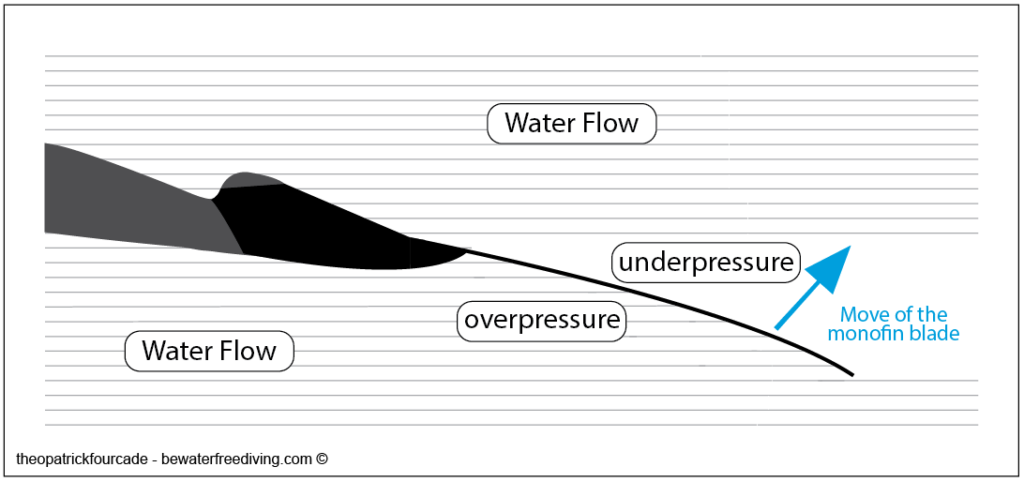
阻力和速度:R = KSV ^ 2
方程 R = KSV ^ 2涵蓋了游泳阻力的幾項變因(R =阻力,K =對應於整體身材的係數,S =身體的正面區域,V =速度)。
注意: R = KSV ^ 2 對於剛體,是正確的。但游泳者是可變的幾何形狀,我們圖減小阻力。測量結果表明,對於游泳者而言,該指。 數小於 2。Di Prampero 給出的指數為 1.2 ,這似乎適用於水下游泳者。對於水面游泳,指數為 1.5 更為接近真實。
在這個校正的方程式中: R = KSV ^1.2 ,表明速度是最決定性的變因。
如果速度為零,則游泳阻力為零。另一方面,此變因對在水中移動時的游泳阻力有重要影響。
如果速度為每秒1m,則:R = KxSx1
如果速度為每秒2m,則:R = KxSx2.3
在自由潛水中,我們通常說的速度約為 1m/s 。因此,游泳阻力不會因速度指數增加,但事實是,如果您的游泳方式不是符合流體。
動力的(K和S效率不高),那麼在整個游泳過程中,會需要更費力地移動。
作為參考,競速蹼泳可以達到 3.6m/s (R = KxSx4.65)。快速游泳確實面臨著不同類型的阻力。良好的圈速意味著減少游泳阻力。
的能力。每次時間進步,就可以有效客觀的改善自己的泳姿。
對於具有良好泳姿的自由潛水者來說,使用單蹼游泳並不是一個不可能的目標。我在自由潛水者中發現的大多數技術缺陷主要來自對單蹼游泳技術的不良學習或完全不學習。導致效率很差的被動和主動阻力,如果降低這些阻力,將會使潛水更容易、更有效率。
例如:降低疲勞、降低耗氧量、降低二氧化碳生成速度、減少乳酸堆積、更加平靜、更清晰、效率更高、更小的 LMC 風險、更小的 BO 風險
因此,必須透過克服游泳阻力的技術來強化自己的泳姿。請記住,在單蹼技術訓練課程中安排(計時)速度相關訓練(使用前呼吸管或練習閉氣衝刺 – front snorkel)。 是不可或缺的!
Theo-Patrick FOURCADE
24/01/2020
Next post : Monofin technique
References :
– Approche Scientifique de la Natation Sportive, 1992 Didier Chollet
– La mécanique des fluides, 1978 Jacques Lachnitt
– La science de la Natation, 1968 James E. Cousilman
– The Energy Cost of Human Locomotion on Land and in Water, 1986 Di Prampero (equation N°17)
You are welcome to use information from the blog, but please specify the source with a link:
Theo-Patrick FOURCADE – bewaterfreediving.com ©
All the illustrations are copyright ©, please ask me before use.

Merci pour cet article très intéressant.
J’imagine que ces explications concernent la nage en piscine…
En mer, rajoutons les résistances liées à la composition de l’eau (plus ou moins salée) et aux courants : quelles sont les incidences du milieu sur la technique ?
Bonjour Isabelle, merci pour ton intérêt 🙂 Toutes ces infos sont valables en mer et en piscine, les mêmes lois de l’hydrodynamique s’appliquent puisque l’on est dans un milieu aquatique. - Avec courant, les résistances seront simplement plus importantes (Le nageur se positionnera au mieux afin de lutter contre le courant ou bien il cherchera à en profiter…) - Une eau plus froide ou plus chaude ne donnera pas les mêmes effets sur la glisse car effectivement la temperature change la “viscosité de l’eau” et donc cela aura un effet sur la performance cette contrainte est notamment liée aux résistances de friction (NB : Les compétitions en piscine, de natation ou de nage avec palmes, pour les grands événements tels que championnats nationaux ou jeux olympiques, sont règlementés et la température de l’eau est imposée afin de fournir toujours les mêmes conditions de performances en cas de record du monde). Le fait d’évoluer en milieu “fermé” (piscine) permet de contrôler un peu mieux le milieu et la performance. En milieu dit “ouvert” (mer, open water) le contrôle est moins évident, c’est souvent l’expérience de l’athlète et de son coach qui font alors la différence pour s’adapter aux contraintes du milieu. Les connaissances de bases en hydrodynamique que je tente d’expliquer permettent et en mer et en piscine d’appréhender le milieu dans lequel on évolue et d’adapter une stratégie « technique » en fonction de l’importance de telle ou telle contraintes hydrodynamiques.
« Quelles sont les incidences du milieu sur la technique ? »
Pour les connaître il faut dans un premier temps comprendre le milieu en identifiant ses contraintes (c’était le but de cet article) dans un deuxième temps il me faudra vous décrire les principes techniques qui tiennent compte des contraintes du milieu… Ce sera le but du prochain article : décrire les principes techniques qui permettent de s’adapter et de performer au mieux avec une monopalme dans un milieu aquatique (immergé).
Ces aspects sont parcourus et enseigner pendant la formation initiateur nage avec palmes de la FFESSM
Bonjour Lucien, heureusement que ces aspects sont vus durant la formation initiateur nage avec palmes (FFESSM) 🙂 Je n’invente rien, je fais juste un résumé de certaines notions de bases. Votre formation reprend les mêmes informations que moi, trouvées notamment dans les références que je cite plus bas dans l’article 🙂 . L’objectif de ce blog est de partager les bonnes informations avec les apnéistes qui utilisent une monopalme et qui n’ont pas accès à une formation comme celle que vous avez eu.
Merci !!!! trés interessant et utile!
Super ! merci pour le commentaire.
La vidéo est trop belle à voir ! Quel travail !
Heu… Merci Maman… C’est ma maman 🙂
C’est jusqu’à présent le meilleur article que j’ai pu lire sur le sujet! Je comprend mieux pourquoi il ne faut pas utiliser les genoux. J’attend avec impatience la suite!
Merci encore
Antoine
Bonjour Antoine, Merci pour le commentaire, l’idée était de faire un petit résumé de quelques notions permettant ensuite de mieux comprendre la technique de nage.
Merci pour le partage! Je n’aurais notamment pas crû que la vitesse entre directement dans l’équation.
Bonjour Pierre. tant mieux si cela peut vous aider à voir les choses avec une nouvelle approche. Merci pour le commentaire.
Deux jours après la publication l’article comptabilise plus 5600 vues, 4300 visiteurs, des connexions venant de 111 pays différents ! Pretty cool ! Merci pour votre intérêt !
Super article, très pédagogique.
On parle de monopalme, mais au final on pourrait appliquer les mêmes principes aux autres nages comme la bi-palme (ou la dnf pour la résistance frontale).
Du coup avec la résistance frontale j’ai compris pourquoi on nous parle toujours d’horizontalité ! Valable aussi pour les départs ! Et le fait que la vitesse soit au carré, ça explique aussi pourquoi on nous demande de pas pousser comme des malades sur les départs. Encore merci !!
Bonjour Enisse
Vous avez bien sûr raison, ces notions s’appliquent à tous les types de déplacement dans l’eau. Je fais le choix pour l’instant de tout rapporter à un athlète qui utiliserait une monopalme afin que ces notions lui apparaissent de façon très concrètes.
Et effectivement en bipalme avec les bras le long du corps, il ne sert à rien de pousser fort contre le mur. Cette position n’est pas hydrodynamique (K, la forme totale du corps n’est pas profilée) et vous allez en accélérant votre déplacement (V^1,2/1,5) considérablement augmenter les résistances frontales et au final produire un effort avec aucun bénéfice.
Malgré tout on peut améliorer un peu cette position, il va falloir que je prévois un article la dessus ! Cette position améliorée je l’ai baptisée RocketMan 🙂 … Promis je fais l’article très bientôt
Passionnant, quelle découverte!
A 71 ans, je pratique l’apnée depuis + de 25 ans dont presque autant en Monopalme, sûrement très mal car autodidacte en la matière, mais complètement addict à cette merveilleuse sensation de vitesse et de glisse que procure cette caudale artificielle. Ayant la chance de bénéficier de la BTV, il m’est arrivé, pour me faire plaisir, de foncer verticalement à + de 3m / s, à en croire mon ordi ! Si les Bi-palmes sont pour moi comme des prothèses, je ressens «profondément» la Mono comme une greffe, un prolongement (presque) naturel du corps! Je ne suis plus Humain à l’instant du canard !
J’attends donc avec impatience les prochains articles, toujours avide d’apprendre pour me perfectionner et, en tant qu’instructeur, pouvoir transmettre le meilleur aux plus jeunes !…
A suivre et merci !
Bonjour Dominique, c’est super de vous lire en exprimant cette passion pour les sensations en monopalme. Effectivement le mode de déplacement avec une monopalme nous transforme en homme aquatique 🙂 J’espère que les prochains posts vous apporteront de nouvelles informations.
Très bon travail de Théo – Bravo
vous pouvez découvrir d’autres petites connaissances en allant voir sur https://www.tours-nageavecpalmes.fr/ressources-de-formation/
Bonjour Fred merci pour ton message. Fred est une Référence en Nage avec Palmes vous apprendrez beaucoup en visitant son lien où il partage le fruit de ses recherches.
Roko Gracin wrote this comment on AIDA INTERNATIONAL (Facebook) he authorized me to publish our conversation :
R.G.: This article has some basic good points but the part on frontal area is not. The main problem is the assumption that freediver moves as a rigid body, as if being pulled by rope. If this was the case you could simply look at frontal area and conclude that larger area causes more drag. However, some freedivers (and all finnswimmers) are not rigid but they move along an oscilating (lets say sinusoidal) curve and each point on the body has its velocity which is not always pointing forward. This approach implies it is important to keep the body as straight as possible, but it is only true for the glide phase, Look at snakes swimming in water for example, what would be their frontal area?
My answer : That’s absolutely true. The surface that will be offered for advancement during the swim will be different depending on when you take a picture of the swimmer. Here to explain the notion of frontal resistance the swimmer in the illustration is in a fixed position. This picture can be misleading indeed… because we can easily imagine that the best way to swim is to stay on an axis and not to move any more, which is not true (it seems to me that it is a fact for everyone that the swimmer with a monofin moves more or less on a sinusoidal trajectory). The notion of frontal resistance just introduces the idea that you have to be profiled during your movement and to be profiled is to offer the smallest possible frontal surface.
If I had described in this “article” the swimming technique then the reader might have better understood the nuance.
Thank you for pointing this out.
Bonsoir Theo, merci bcp pour ce magnifique article! J’ai essayé de trouver l’étude physiologique de Di Prampero qui définit l’exposant 1,2 au lieu de 2 – pourrais tu indiquer la référence exacte STP.
Merci bcp par avance
Maher
Bonjour Maher, merci pour ce commentaire. Voici le document en question (équation N°17) : DI PRAMPERO
Hello Theo
You explained very clearly. I easily understood the basic knowledge. Very nice. Thank you for this information. I’m waiting for the next post.
Thank you very much!!
Thank you very much ! 🙂
Stats for this article : 10100 views , 7400 visitors from 129 countries !!!
Enjoyed every bit of your blog.Really looking forward to read more. Great.
Thank you for your comment !
I’m trying to block time to write more !!!
I do it asap !
Very descriptive blog, I liked that a lot. Will there be a part 2?
Hello, thank you for your comment. Yes will have a part 2 and more. I am working on it. 🙂 You can subscribe to the newsletter to keep in touch. Best Regards.
My brother suggested I might like this website. He used to be totally right. This post actually made my day. You cann’t believe simply how much time I had spent for this information! Thank you!
you will get more in the next article 🙂 thank you for your comment
Like!! I blog frequently and I really thank you for your content. The article has truly peaked my interest.
Great 🙂 !!! thank you !!!
Nice post. I learn something new and challenging on blogs I stumbleupon everyday. It’s always exciting to read articles from other authors and use a little something from their sites.
Cool if you find my article useful ! Next one will blow you 🙂
I had been suggested this website by my cousin. I’m not sure whether this post is authored by him as nobody else know such detailed about my trouble. You happen to be incredible! Thanks!
Thank you. I hope the next article will help you more !
Spot on with this write-up, I absolutely think this web site needs far more attention. I’ll probably be returning to read through more, i appreciate you the advice!
thank you for this comment !
certainly such as your web-site however you must check the spelling on quite a few of the posts. Many turn out to be rife with spelling problems and that i find it very troublesome to know the truth on the other hand I’ll certainly come back again.
sorry to read your comment. i don’t speak good english which explains the spelling and grammar mistakes. my friends who are english give me a hand on their free time… we’ll try to do better. but don’t hesitate to let me know the worst passages.
Hello mates, good article and good arguments commented here, I am really enjoying by these.
i enjoy too 🙂 thank you
It’s gonna be ending of mine day, but before ending I am just looking at this wonderful article to increase my know-how.
nice nice !!! happy to be usefull
Very rapidly this website will likely be famous among all blogging visitors, as a result of it’s good posts
would be cool !
Wow that was odd. I just wrote an incredibly long comment but after I clicked submit my comment didn’t show up. Grrrr… well I’m not writing all that over again. Anyhow, just wanted to say wonderful blog!
sorry to read that !! thank you for your comment !!!! i hope you will appreciate the next article about the monofin technic
It’s an awesome paragraph in support of each of the internet viewers; they will obtain advantage from this I am certain.
Things are very open using a specific clarification of your issues. It had been really informative. Your site is useful. Thank you for sharing!
thank you !!! I keed writing !!!
I actually do trust all the concepts you have introduced on your post. They’re really convincing and might certainly work. Still, the posts are too short for novices. Could you please lengthen them just a little from next time? Thanks for that post.
Hello Thank you for your comment. the next article will certainly satisfy you… waiting your comments… just be a bit patient …it is long to write 🙂
I just start to practice monofin, and I am so happy to see all those articles at the beginning stage, it helps the starter to know and understand the background the technical theory. Would be expected to see more sharing on the news!
Thank you 🙂 i am happy to share 🙂 i will continue 🙂
Merci Theo! Tres interessant!
Thank you Davide !!!